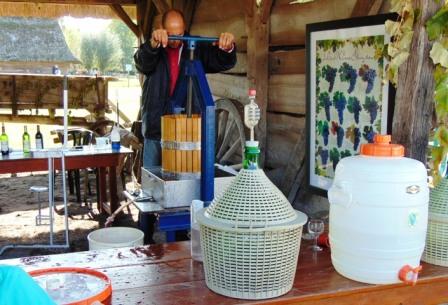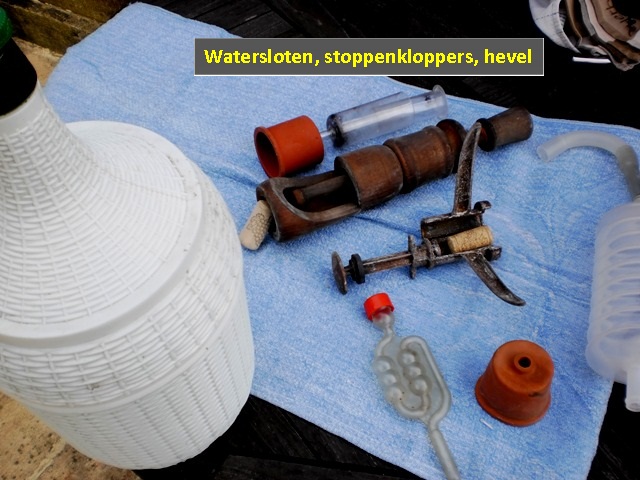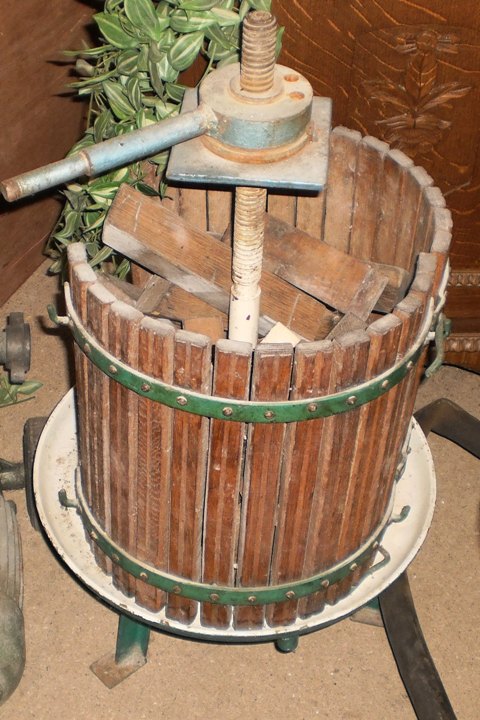One of the 60 botanical similar species, Vitis vinifera began about 7,000 years BC to carry fruit that fermented to wine. The term wine is usually reserved for fermented grape juice. You can also make (fruit) wine from other fruits, flowers, herbs, birch sap.
 On the skin of the grape all kinds of wild yeasts appear.
On the skin of the grape all kinds of wild yeasts appear.
A few days before the harvestyou can make a yeast starter by picking some grapes (or...), bruising them occurs spontaneous fermenting. Once started, you can continue to feed him (with juice and sugar). Earlier this provided good results. Perhaps because the lees (dregs of wine) always went back to the vineyard as fertilizer and in that way a natural selection and cycle was created that delivered a suitable yeast strain.
To avoid contamination with other spores and yeasts you can autoclave all material, make it germ-free in a pressure cooker. In this humid heat of 121°C, all micro -organisms and their possible traces are destroyed.
In order to maintain a yeast culture usually agar, a product made from seaweed gelling- or binding agent is used, with (sterile) water and malt extract.
For a starter you put the medium with the yeast at room temperature. Good yeast is recognized by
a smooth start of fermentation within 24 hours, and the absence of unwanted (sour) odor and stringy substances.
 Yeast converts present sugars in carbon dioxide and alcohol. Very ripe fruits contain more sugars. Collect, select and clean them. Stalks give a bitter taste. Press the fruit: this (unfermented) juice is called must. 10 kg of fruit yields 6 to 8.5 liters of juice.
Yeast converts present sugars in carbon dioxide and alcohol. Very ripe fruits contain more sugars. Collect, select and clean them. Stalks give a bitter taste. Press the fruit: this (unfermented) juice is called must. 10 kg of fruit yields 6 to 8.5 liters of juice.
Solve (1/3) sugar (1/3) warm water and add to (1/3) juice, along with the yeast. The ratio is very rough, depending on desired flavor and alcohol, and the sugars that are already present in the juice, acids and nutrients. Books, clubs and sites can guide you substantiated and in detail.
To increase the alcoholic strength by one percent you should add 17 grams of sugar per liter of wine extra.
The fermentation comes to an end when the sugars are consumed, or when the alcohol content comes above ± 15%.
Completely fermented wines which do not contain any more sugar, are called dry wines.
After a first (violent) fermentation the wine is siphoned from the dregs into another bottle for a second, if needed later a third or fourth fermentation. Fermenting bottles are air sealed with an airlock so that CO2 can escape. A hose pinching around the bottle neck with the end suspended in a beaker of water works the same way (but can suck at the end of the process by under pressure sometimes water (and bacteria) in the bottle!).
 To keep all processes under control hygiene is especially important. All materials must be properly cleaned. For example with soda and then rinse well with a sulfite solution (5 liters of water, 10 grams potassium (disulphite) and 1 teaspoon citric acid) to disinfect. Then everything can be rinsed with 10 minutes boiled water.
To keep all processes under control hygiene is especially important. All materials must be properly cleaned. For example with soda and then rinse well with a sulfite solution (5 liters of water, 10 grams potassium (disulphite) and 1 teaspoon citric acid) to disinfect. Then everything can be rinsed with 10 minutes boiled water.
Potassium pyrosulphite (K2 S2 O5) or sulfite: binds oxygen. This gives fungi, bacteria and chemical oxidation products no chance to multiply or develop.
In a pulp fermentation (hard) fruit is bruised. Then let them soak capped, possibly with yeast and pectin enzymes. They then can be pressed better. This is necessary for red wine, the yielding pulp and shells create the color. Because of oxidation this is not recommended for apple and rhubarb.
Rose wine is made like red wine from red grapes. The peels are usually separated within 24 hours of the must.
Field maple or Spanish barge (Acer campestre) also has sugary juice (like birch) that can be tapped to make wines and spirits.
Cleaning bottles
To wash bottles there are bottles brushes and spiral brushes. We used to use soapy water and lead pellets from a shotshell. Firmly shaking and turning, then rinse and pour through a sieve. Can also with gravel and pebbles.
Archaeologists from the universities of Munich and Tübingen investigated and dated food remains in a prehistoric settlement from the early Iron Age (800 - 500 BC) in the southern German Heuneburg. They concluded that wine, probability imported from the Mediterranean, was presumably drunk by all groups of the local population, and not just by the elite.
‘Swedish wine needs no bush. Who drinks it probably do.’(Johan Anthierens)
‘Wine is water, filled with sunshine.’(Galileo Galilei)
